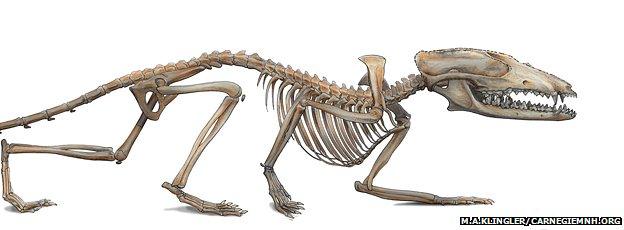Fossil redefines mammal history
- Published

Its body would have been just a few cm in length. Its feet indicate it often scurried about in the trees
A small, 160-million-year-old Chinese fossil has something big to say about the emergence of mammals on Earth.
The shrew-like creature is the earliest known example of an animal whose kind evolved to provide nourishment to their unborn through a placenta.
Its features clearly set it apart from marsupial mammals, which adopt a very different reproductive strategy.
The discovery pushes back the date the two groups took up their separate lines, according to Nature magazine.
The journal carries a paper written by a team of palaeontologists led by Zhe-Xi Luo from the Carnegie Museum of Natural History, Pittsburgh, US.
It describes the fossil remains of an animal unearthed in China's northeast Liaoning Province, which has produced so many stunning fossils in recent years.
The new specimen, which the scientists call Juramaia sinensis, records many of the key features of the long-dead organism, including its skull and even impressions of soft tissues such as hair.
But, most importantly, the Juramaia fossil also retains a full set of teeth and forepaw bones.

Its hand structure suggests that it was a capable climber
It is these parts that have enabled palaeontologists to place the creature among the eutherians, or what we more commonly would refer to as placental mammals; as opposed to the metatherians, whose descendants include marsupials such as kangaroos.
"The teeth of Juramaia show all the typical eutherian dental features," Dr Luo explained.
"Specifically, eutherians have three molars, and five premolars. This is in contrast to metatherians characterized by four molars and three premolars.
"Details aside, the difference in teeth of Juramaia allow us to identify it as belonging to the eutherian lineage. In addition, the forelimb and wrist bones show some eutherian features; they completely lack the important diagnostic features of metatherians-marsupials," he told BBC News.
The Liaoning specimen is especially significant because it means the fossil record now sits more comfortably with what genetic studies have been suggesting about the timing of the emergence of the different mammalian lineages.
These DNA investigations had indicated that eutherians should have been in existence much earlier than the previous oldest-known eutherian fossil - a creature called Eomaia, which lived about 125 million years ago.
Juramaia's appearance in the Jurassic Period of Earth history would appear to corroborate what the genetics has been saying.
Today, 90% of all mammals, which include humans of course, are placentals. Knowing the timing of the split from marsupials is fundamental to understanding the full story of the evolution of mammals.
Another interesting aspect of the discovery is what the fossil can tell us about the lifestyles of the early placentals, and it seems they were pretty adept at climbing.
"Juramaia is an insectivorous mammal. It weighed about 15 -17 grams, more or less the size of a shrew," Dr Luo said.
"Its hand structure suggests that it was a capable climber. So we interpreted it to be a tree-climbing insectivorous mammal hunting insects for living," the Carnegie Museum researcher told BBC News.

- Published26 November 2010